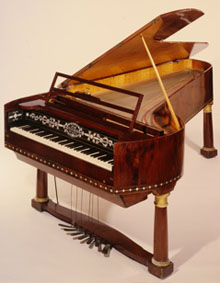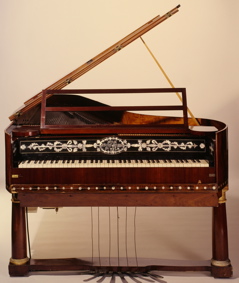Claviorgan/Organ piano by Joseph Böhm,
Vienna a1830
One of the few preserved pianos with an organ rank, here an overblowing "Flute"
This stop adds an ethereal quality, the other mutations, Janissary pedal, Bassoon, Moderator, Damper pedal, offer a variety of timbres for new and surprising sound effects for the interpretations of variations or musical epics. Apart from these there is a pedal for the organ bellows, and an on/off pedal switch for playing the organ stop only.
It is still not quite clear, when Böhm begann building pianos with organ ranks, a first indication is in "Darstellung des Fabriks- und Gewerbswesens im österreichischen Kaiserstaate" 1823, S. 197/8.
The technical layout and mechanism of the instrument reveals Joseph Böhm's art of craftsmanship at the highest level. The instrument has a special importance as a document of historic pitch by its organ rank of 432 Hz. Mehr
An original tuning manual in Italian preserved with the instrument could indicate it might have been ordered by a customer in the italian-speaking countries of the Austrian monarchy. Since the aged construction of the instrument would no longer withstand a string tension of the 432 Hz standard, it was a peculiar task to build an interchangeable rank of flute pipes following the old mensuration at a lower pitch level to experience the specific sound abilities of this instrument.
Musical interpretation is determined by the musical properties of the media of sound. The variations of sounds in this grand piano offer a multitude of ideas of expression which can hardly be experienced otherwise. Technical construction interacts with esthetics and cultural context of a remarkable instrument.
© Greifenberger Institut für Musikinstrumentenkunde | info@greifenberger-institut.de






